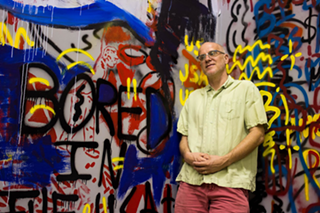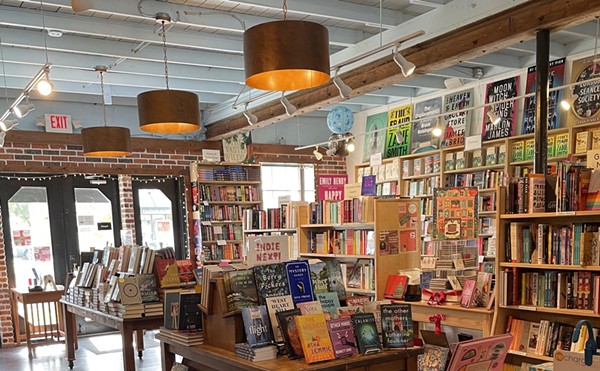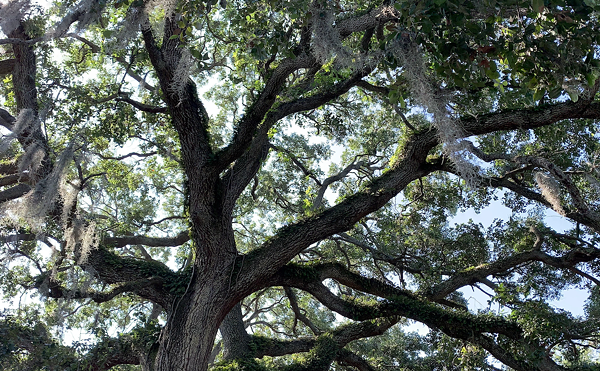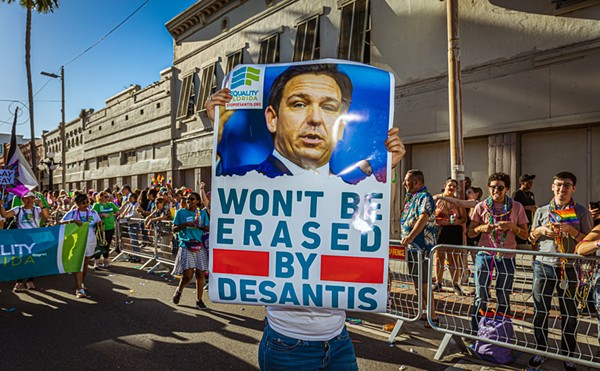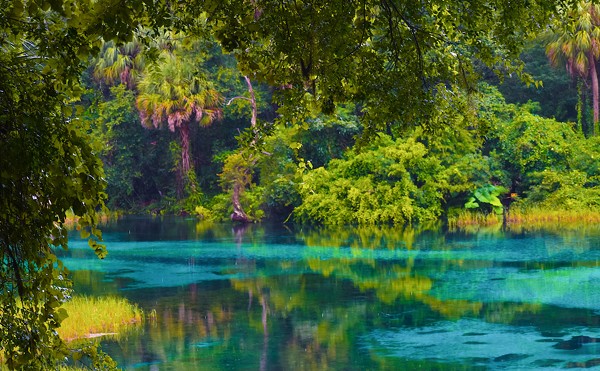St. Petersburg was a new city in 1894, its downtown streets, a rutted and sandy mess. Looking for fill, town fathers did what Floridians did at the time. They razed five of the six closest shell middens, from what was known as Mound Park.
Ancient history lies under the pavement.
The sixth and final shell "mount" stood where it had for thousands of years, until 1950. When "Mound Hospital" (now Bayfront) needed to expand, city council voted to raze the last of its downtown middens. The site had not always been well maintained, but it remained popular as a tourist destination. Postcards still turn up at antique stores (see above). Today the last of the "Mound Park" middens is buried under the driveway into Bayfront Health. The oyster shells were used to fill potholes.
This story speaks volumes about the relationship between St. Petersburg and its native past. Archaeologist Robert Austin chronicles the history in a recent paper for the “Florida Anthropologist.” Austin describes a "sorry saga" in painful detail, spinning a case study in the "competing interests of history, preservation, and development"—topped with a heavy dollop of "cultural insensitivity."
The loss of Mound Park is ours, obviously, because the Indigenous built environment of Pinellas County was—and is—really cool.
For 800 years, from roughly 900 A.D. to the early 18th century, Tampa Bay was the epicenter of Safety Harbor Culture, a period that followed the related Weeden Island era and that lasted well into colonization. The Spaniards, for the most part, left the central Gulf Coast alone. Expeditions by Pánfilo de Narváez (who landed in 1528) then Hernando de Soto (1539) yielded neither gold nor agricultural communities to exploit.
Native people first appear in historical records as the Tocobaga (toke-o-BAH-guh), and they probably spoke Timucua, a creolized "isolate," with roots in the Amazonian rainforest, plus loan words from Caribbean and Muskogean language trees. Timucua, more a cluster of dialects than single idiom, was preserved in church accounts.
What were they speaking on the St. Pete mounds that became road fill?
The Safety Harbor people, like the Weeden Island culture before them, left clues about how they inhabited this area. They lived and worshipped on the shell mounds, typically found near the coast and fresh-water sources. They buried their dead in sand-filled mounds. Austin notes some 200 hundred sites around Tampa Bay, although before development, there were three or four times that number.
Floridians have a habit of loading these sites with half-provable stories from the Spanish invasion. Antiquarians like Walter Fuller started slapping significance to places like Jungle Prada or the Anderson mound, in the 1930s. Signs still claim that mound for Pánfilo de Narváez, whose disastrous expedition was chronicled by Álvar Núñez Cabeza de Vaca—though concrete evidence of that particular encounter has still not surfaced.
Princess Mound, down in the “Pink Streets” of lower Pinellas, offers a smorgasbord of interpretation, claiming the rescue of Narváez castaway Juan Ortiz by "Princess" Hirrihigua (or Ulele) and also the death of Dominican martyr Luis Barbastro de Cáncer.
Take most of these stories with a grain of Boca Ciega sea salt.
No one can deny the importance of Spanish arrivés to La Florida. But we fail to keep Native people at the center when we focus on one week, or even one day, in a history measured by centuries and millennia.
Visiting the Safety Harbor sites around Pinellas invites us to slow down, soak in the landscape, and savor what makes living in Tampa Bay special.
A few weeks back, my wife Julie and I took our puppy Yngve to Philippe Park, in Safety Harbor. Yngve is a Norwegian Buhund, or hut hound, named after my Scandinavian great uncle. He is a handsome pooch, I must confess, and a sure conversation starter.
With Yngve on a close leash, we strolled through the former village of Tocobaga, which the adelantado (or governor) Pedro Menéndez de Avilés visited in 1537. We wound our way to the main ceremonial mound, through a pleasant hammock of hickory and live oak, enjoying the afternoon breeze off Old Tampa Bay.
The puppy served as our introduction to folks from all over the country. Across the main mound's west face, in what used to be a central court a drum circle pounded away. Park picnic picnic shelters were decorated for Sukkot, the Jewish harvest celebration.
We climbed the stairs up the midden, then descended the ramp on the opposite side. A funereal mound sat off to the distance, in the woods, not far from where the drum circle beat out its sacred rhythm.
The interior-spiritual life of the Tocobaga must remain an open question. But as Julie and I took in this Safety Harbor "type" site, we had to register one obvious fact: Florida's first people knew where to build.
They chose spots for their central villages where fresh met brackish water, ecotones with multiple food options, and they used elevation to catch breezes and cut the mosquitoes. Then and now, the cool hardwood hammocks break an afternoon glare; the village of Tocobaga remains an exceptionally peaceful place.
A similar vibe permeates nearly every Safety Harbor site. Apart from Pánfilo de Narváez, Jungle Prada keeps its cool in every sense of the word. At Maximo Point, just past the incessant hum of the Sunshine Skyway Bridge, kayakers mingle with picnickers and old heads playing disc golf. The Maximo site, fragmented by road building, probably once linked to the complex around Princes Mound, in a neighborhood that early boosters called "the healthiest spot on earth."
As Thanksgiving nears, and election panic cools, we settle into the delight of Florida's Autumn. It behooves us to express gratitude for the place where we live.
No denying, the arrival of Europeans brought horrific ends to Florida's first people. Conquistadors introduced pathogens, Christian missions demanded labor, and over the centuries, populations steadily declined.
Today we have only the relics of the Timucua language, the lingua franca of Florida. Records suggest it was a localized tongue, with dialects varying from town to town.
If the Safety Harbor people were here today, what would they speak? Could they have communicated with the archaic groups who built the middens at Mound Park?
One will never know for sure, though linguists over the years have reconstructed a Timucua grammar and vocabulary from the scraps of Spanish documents.
One useful word is "quoso," meaning "dar gracias"—to praise or give thanks.
We live in a beautiful place. We survived a terrifying election and season of storms. The November weather invites us outside. Go visit a mound, some shady place where water meets land. Go there to remember. Give praise. Quoso.
Say it as the Tocobaga did: ysaco niquosonihaue nimantela. Thank you.
Thomas Hallock teaches English at the University of South Florida in St. Petersburg. To learn more about Tampa Bay's archaeological heritage, go to cgcas.org.
Support local journalism in these crazy days. Our small but mighty team is working tirelessly to bring you up to the minute news on how Coronavirus is affecting Tampa and surrounding areas. Please consider making a one time or monthly donation to help support our staff. Every little bit helps.
Subscribe to our newsletter and follow @cl_tampabay on Twitter.



